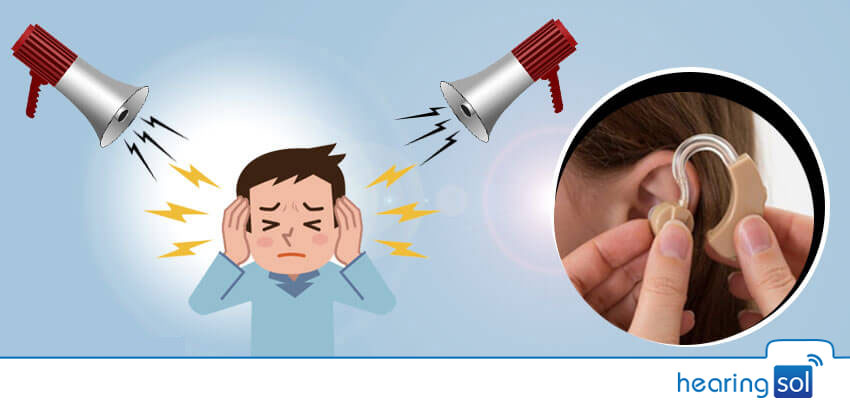
Most sounds that we experience in our daily environment such as sounds from the radio and tv, traffic, household appliances etc. These sounds are at safe levels and don’t damage our hearing.
You can purchase the latest hearing aids at a fair price through HearingSol, If you need any assistance or you have a query regarding Hearing Aid or Noise-induced Hearing loss (NIHL), feel free to call us at +91-9327901950. We are always here to help you.
The most normal feature of our life is the means of communication. A normal sound is enjoyable but a loud sound is unpleasant. The loud noise heard for a long time leads to the damaging of the sensitive structure of the inner ear, causing ear damage which results in Noise-Induced Hearing Loss.
According To NIDCD, nearly 1 in 4 (approx 24 percent) between 20- 60 years are victims of noise-induced hearing loss.
Noise-Induced Hearing Loss (NIHL)
If the sound is loud enough and the duration of tolerating is long enough, however, but it may cause a long-lasting threshold shift. This situation is called noise-induced hearing loss. Noise-induced hearing loss (NIHL) is hearing impairment outcoming from exposure to loud sound. Many People may have a loss of approach to a narrow range of frequencies, impaired connective awareness of sound, or another impairment, accepting sensitivity to sound or ringing in the ears.
Hearing can deteriorate gradually from constant and repeated noise exposure, like loud music or background sound, or all of sudden, from a less high-intensity sound such as a gunshot or air horn. In both the types, loud voice overstimulates delicate hearing cells, leading to the long-lasting injury or death of the cells. If it once lost, then the hearing cannot be restored in humans as before.
Noise-Induced Hearing impairment is caused by one-time exposure or continuous exposure to loud noises. The sound is measured in units called decibels. Less than 75 decibels or above 85 decibels can cause hearing loss. Below is some main reason behind this damage:
Industrial sources – The Printing press, textile mills, and Construction and carpentry cause extreme noise pollution.
Public Address system – In India, people just want an excuse for using loudspeakers whether its marriage, death, or birth which contributes to noise pollution.
Transport Vehicle, Household chores, and Road traffic noise also contribute to noise pollution.
According to The Effects of living in a noisy world, noise-induced hearing impairment is the most widespread irreversible occupational hazard.
Some Facts & Figure about Noise-induced hearing loss
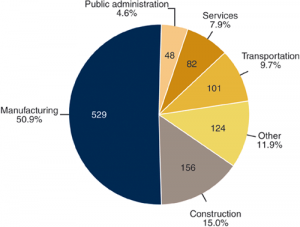
❯ Around 30 million workers in America suffered from excessive noise at their jobs.
❯ In manufacturing and agriculture, workers at the age of 50 experience hearing impairment three times more as compared to others. In other industries, this incidence is up to six times.
❯ In construction and mining, 2 out of 3 workers will suffer from hearing loss by the time they attain 50 years of age.
❯ According to a recent survey by the Deafness Research Foundation has shown that greater than 65 percent of returning combat troops from Afghanistan exhibit symptoms of noise-induced deafness or sustained acoustic trauma.
❯ Farmers are three times more prone to hearing impairment as the average American.
❯ When you talk about work-related ailments, among firefighters hearing impairment has acquired the second position from the top due to exposure of machinery, sirens, and other kinds of tools.
❯ In the US, among all the noisiest sectors, the manufacturing sector is one of them and it is responsible for the highest number of occupational hearing loss cases.
If you suspect any type of hearing loss, the very first step is to consult hearing care professional right away. Give us a call on our toll-free +91-9327901950.
Importance of Noise-Induced Hearing loss
The industrial and technological revolution may have driven society to higher levels from the lower levels of achievement, but this growth has also made the world a noisier place in which people have to live. In fact, noise pollution is an increasing health hazard and can be found easily almost everywhere. Rescuing to the country may not provide a quiet refuge, and even farmers are at high risk for a hazard to noise from their farm machinery.
Undesirable or unwanted noise is not the only harmful noise to which we have exposure. The music at a show and the pounding of a jackhammer on the street can be an equal impairment to the inner ear. Loud noise delivered with equivalent intensity or over extended periods of time, regardless of their origin, are equally hazardous. Ultimately, continued or iterated exposures to high-intensity sound can cause acoustic trauma to the ear. This trauma can outcome in hearing loss, vibrating in the ears, and occasional dizziness (vertigo), as well as non-auditory effects. Like increases in heart rate and blood pressure.
Sign & Symptoms of Noise-Induced Hearing Loss
The symptom of noise-induced hearing loss is usually adversity hearing a conversation against a noisy background. The consequence of hearing loss on speech perception has two components. The very first component is the loss of audibility, which is something such as a decrease in overall volume. Most of the Modern hearing aids atone this loss with amplification.
However, adversity in learning speech represents selective frequency loss for which hearing aids and amplification do not use to help. This is called by different names like “distortion,” “clarity loss,” and “Signal-to-Noise-Ratio (SNR)-loss”. Hearing loss can influence either one or both ears. When one ear is not working properly, it causes problems with directional hearing. Directional hearing offers the ability to analyze from which direction the sound came.
Which type of hearing loss is a noise-induced hearing loss?
Types of Hearing changes –
❯ Temporary hearing loss – Sometimes hearing loss is only for 16 to 18 hours but that may cause long-term damage to the hearing of a person later.
❯ Long-term hearing loss – Long-term exposure to loud noises leads to starts losing hearing and later it may be difficult to understand what other people talk which leads to long-term hearing loss. A Loud sound will also source some people to have anxiety and irritability. An increment in heart rate and blood pressure, or expansion in stomach acid.
❯ Immediate hearing loss – Sudden exposure to extremely loud noises such as explosion or gunshots may lead to rupturing of the eardrum or damage the bone in the middle ear. This type of ear damage can result in a permanent hearing loss.
Apart from hearing loss, here are some external signs of acoustic trauma:
❯ Tinnitus – It is a sign that defines the inner ear damage or nerve destruction that has occurred. Long-term exposure to loud noise can cause tinnitus – ringing, roaring in the ear or head. Originally the tinnitus is temporary, lasting only for several hours or you can say volatile. As more cumulative hazard and damage occur, the tinnitus will be long-lasting until it eventually becomes permanent.
❯ Physiological response – Below are some of the signs of physiological response –
❯ The hair of the hair cells got bent and broken which lead to the damaged hair-cells degeneration. This type of hearing loss is irreparable.
❯ The exposed area got inflammation and causes bad blood flow and bad oxygen supply inside the exposed blood vessels. That later results in damaged hair-cells degeneration.
❯ Noise overstimulation leads to the maximum release of glutamate and leads to swelling and bursting of the postsynaptic bouton. This type of hearing impairment can be recovered in around 2 to 3 days.
Read more :- Link between tinnitus and hearing loss
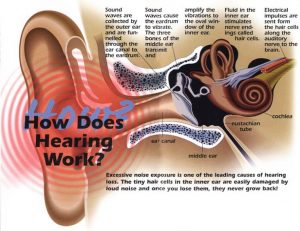 How NIHL creates hearing damage
How NIHL creates hearing damage
Mechanism
- Sound waves enter the outer ear and pass through your narrow ear canal, which then travels to the eardrum and then sends vibration.
- These vibrations pass through three connected bones malleus, incus, and stapes in the middle ear.
- Then these vibrations begin to amplify and start vibrating sounds through vibrations.
- Then these sound vibrations pass to fluid present in the cochlea, Then this fluid bend the tiny hair cells receptors, that later trigger electrical signals in the auditory nerve, that travel to your brain.
In the case of loud noise, the intensity of vibration got increased which cause the motion of fluid in the cochlea. And it results in the breaking of the hair cells. As we all know our hair cells are not replaceable. Also, if the hair cells got damaged then there is no way of going back.
These hair cells are not useful in triggering the electric signals to the brain which results in hearing impairment. Noises of any kind whether it’s loud such as gunshot or short noises can lead to your hair cell damage. At last, your brain starts translating these signals into sound which we hear and understand.
Who is affected by NIHL
People of all ages including children can be affected by NIHL. In a study, it is found that about 15% of Americans between the age of 20 to 69 suffer from NIHL. On a daily basis, more than 30 million Americans are in the dangerous zone of hearing loss. Around 12.5% percent of children age 6 to 9 are suffering from permanent hearing loss. But there is a hope that about 99% of noise-induced hearing loss is preventable. Any noise above 85 decibels is dangerous for hearing. Doing the job in a noisy area also promotes hearing impairment.
NICL in Military Environment
The sources of noise in the military are carried out by the members of the Navy, Marine Corps, Army, and Coast Guard. Military members are constantly exposed to high levels of noise. They have little option but to remain in noisy environments so as to complete specific tasks and missions. Sources that are obvious of potentially hazardous noise are jet engines and weapons systems, but vehicles, watercraft, aircraft, and communication systems are also sources of potential noise damaging.
What Causes Noise-Induced Hearing Loss
The intensity of sound is measured in decibel(dB). The scale range is from 0 dB to 180 dB. On a Noise-Induced audiogram, sound intensity is measured at the hearing level. Higher intensity of sound can damage ears. Sound intensity above 180 dB is considered as dangerous level.
Hearing Loss Decibels Chart
Let’s get aware of some common sounds and their intensity
| Sound intensity | Sounds |
| 0 dB | the quietest sound you can hear. |
| 30 dB | whisper, quiet library. |
| 60 dB | normal conversation, sewing machine, typewriter. |
| 90 dB | lawnmower, shop tools, truck traffic; 8 hours per day is the maximum exposure (protects 90% of people). |
| 100 dB | chainsaw, pneumatic drill, snowmobile; 2 hours per day is the maximum exposure without protection. |
| 115 dB | sandblasting, loud rock concert, auto horn; 15 minutes per day is the maximum exposure without protection. |
| 140 dB | gun muzzle blast, jet engine; noise causes pain and even brief exposure injures unprotected ears; maximum allowed noise with a hearing protector. |
The frequency of sound 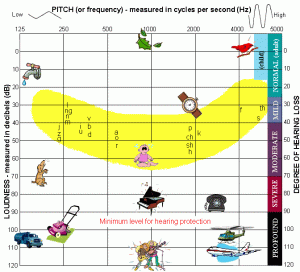 is measured in hertz(Hz). The frequency of sound vibrates per second sound. Higher the pitch of the sound and will be the higher frequency. Generally, the frequency of noise-induced hearing loss is about 2000-4000 Hz.
is measured in hertz(Hz). The frequency of sound vibrates per second sound. Higher the pitch of the sound and will be the higher frequency. Generally, the frequency of noise-induced hearing loss is about 2000-4000 Hz.
Young children have the best hearing and having a frequency of 20 Hz. Sound can also be distorted due to loss of frequency that’s why speech is difficult to understand even though it can be heard.
Hearing disabled people often have difficulty detecting differences between certain words that sound alike, especially words that contain S, F, SH, CH, H, or soft C, sounds. The sound of these consonants is in a much higher frequency range than vowels and other consonants.
Duration is defined as how long you are exposed to noise. It can affect the extent of noise-induced deafness. The longer you are exposed to loud noise, the more damage it will cause.
Occupational noise-induced hearing loss is one of the major causes of noise-induced deafness. It is a very serious difficulty because a vast community is working in various industries. In India, the occupational working hour is about 8 hours and the weight-age limit is about 90 dB. Studies carried out by the National Institute of Occupational Health, India, stated that the sound pressure levels were very high in various industries.
Data on occupational noise
| Industries | Range |
| Road traffic | 60-102 |
| Surface rail traffic | 90-102 |
| Metro rail | 70-111 |
| Air traffic | 90-112 |
| Textile industries | 102-114 |
| Pharmaceutical firm | 93-103 |
| Fertilizer industries | 90-102 |
| Oil and natural gas complex | 90-119 |
Non-occupational noise: These are the regular basic noises that defect hearing. Noises which we hear our surrounding such as music, loud voices, crackers, video, motorboats, plain, etc. Listening to loud music and attending a live concert may also cause noise-induced hearing impairment.
Here is some data on non-occupational noises
| Noise | Level |
| Firecracker | 180 dB |
| Gunshot | 167 dB |
| Car Stereo | 154 dB |
| Children’s toys | 150 dB |
| Sporting events | 127 dB |
| Rock Concert | 120 dB |
Biological causes of noise-induced hearing loss:
There is a strong relationship between noise and hearing loss. More you will be in a noisy environment will cause more harm to your ear. Excessive noise may lead to your hearing loss permanently. Today everyone is in the race of doing work and earning money but they do not have time and awareness for their health and their surroundings. Peoples are totally unfamiliar with that their working climate is healthy and secure for their sense organ or not.
Age-related hearing loss: This is caused by malfunctioning of the middle and outer ear. Due to the age problem function of the eardrum, and also a function of three tiny bones are reduced. Thus noise can easily affect old people due to their weak eardrums. It is advisable that people above 50 years should take care of loud backgrounds.
Damage to the inner ear: Inner ear is damaged due to damage to the vestibular system. It includes the parts of the inner ear and brain that help control balance and eye movement. It causes many major problems. This damage is done due to excess noise.
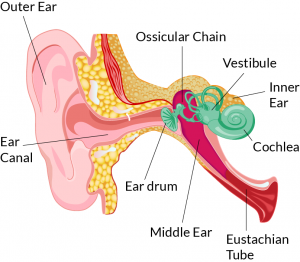
A gradual buildup of earwax: Hearing impairment is caused by extra ear wax. It is a form of conductive hearing loss. This kind of hearing difficulty occurs with age or as a result of exposure to intense noises.
Ear infection and abnormal bone growths or tumors: There is no exact cause of these tumors. But spending time more in a noisy area or in high-frequency sound level leads to permanent hearing loss.
Ruptured eardrum (tympanic membrane perforation): There is a hole or tear in a thin membrane known as a ruptured eardrum. This happens due to working in a loud background or using equipment producing constant noise. Usually, it starts functioning itself otherwise surgical treatment is needed.
How Noise-Induced Hearing Loss Is Diagnosed?
Noise-Induced Hearing Loss is caused by acoustic trauma and it also starts developing gradually over time. This gradually developing loss of hearing can often be characterized by a certain type of pattern which is presented in audiological findings.
Characteristics of NIHL
At 4000 Hz NIHL usually affects any person hearing sensitivity. Noise-induced deafness generally linked with the notch – a high-frequency loss which is worst at this frequency range(4000 Hz). But notch also is present at 3000 or 6000 Hz. Researchers also refer to this notch as “Muna”.
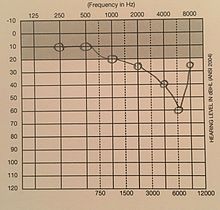 The symptoms of NIHL are shown both the ears equally. The variation in frequency from individuals’ ear canal resonance, length of noise exposure, and frequency of hazardous acoustic signals. With constant exposure to noise, these frequencies become worse gradually.
The symptoms of NIHL are shown both the ears equally. The variation in frequency from individuals’ ear canal resonance, length of noise exposure, and frequency of hazardous acoustic signals. With constant exposure to noise, these frequencies become worse gradually.
In most cases of noise-induced hearing impairment starts at a high frequency such as 3, 4, or 6 Hz and then later goes to a low frequency such as 1 or 2 Hz.
As the symptoms of loss of hearing are not painful, so it might be difficult to recognize them soon. It might be initially you can notice continuous ringing in your ear (tinnitus) or also can stop reacting to background sounds. All this can happen at the starting of high-frequency hearing loss.
Therefore, consulting a doctor can help. Depending on your hearing test doctor will suggest to you whether you have any kind of ear infection, impacted wax. In case the hearing difficulty is due to loud noise.
Is It Possible To Prevent Hearing Loss?
Noise-induced hearing loss is only one kind of hearing impairment that one can prevent if he/she practices good hearing health. It becomes a necessity for everyone to understand the risk of noise pollution. The best and first option for preventing hearing loss is lowering the volume of sound at its source carefully. Then secondly, reducing the time of exposure to loud noise can reduce injury. At last Finally, the physical protection from the sounds can reduce its impact. Government adjustment has a design to limit occupational exposure to dangerously loud noise.
Preventing NIHL In Children
Both the children and teachers get affected by poor classroom acoustics. In many of those cases, it is the school authority’s responsibility to take suitable steps. Also, make an environment for good communication.
Tips to reduce the noise level inside the classroom are –
- In a large open area, a teacher should try taking classes, and also avoid multiple classes,
- Provide proper information about noise pollution,
- When not in use, all kind of noisy equipment can be switched off,
- Try to use soft material for the floor which can help in reducing the noise level,
- Whenever possible, try to close all the doors and windows properly,
- At home also, try not to let your kid play with toys that produce noise.
A parent should try to discard all the toys available at home which causes noise pollution. Or parents can also remove the batteries from the toys. Also, while buying new toys for your kids, parents should first check the noise level of the toy and in case the sound is loud for your children then they should avoid buying that toy.
Preventing NIHL In Adults
Construction workers, disk jockeys, mine workers, musicians, and Firefighters most of the time work in the presence of machinery noises. These occupational noises often result in physiological damage such as stomach problems, increased heart rate, or affect the overall work performance of adults at their job.
Tips for adults to prevent occupational noise
- Consult your doctor for the hearing test.
- Try to follow all the safety measures needed in the workplace.
- Use personal noise reduction devices such as earmuffs, earplugs
- Each and every employee of the company should regularly attend the annual hearing conservation programs. Also, get themselves tested and trained and educate each other on hearing protection.
- The company also regularly maintains the record of the sound level present in the existing environment.
- Employees should take regular auditory test and training activities of the concerned company.
- Exposure to more than 85 dB noise can lead to permanent damage of hearing.
- Use of helmet fitted with earpad and ear proofs while driving.
- Sound insulation at construction stages.
- Noise pollution control in an automobile.
- Follow the 60/60 rule. No more than 60 minutes hearing up to 60% volume.
To Protect your hearing you can check different sounds by the National Institute on Deafness and other communication disorders (NIDCD) in their noise meter.
Treatment of Noise-Induced Hearing Loss
It is mostly stated that Noise-induced hearing loss is irreversible but according to an article on Treatment of noise-induced hearing loss after-treatment of the exposed person with the stay in silence, environmental noise below 70 decibels for three weeks there is a chance for recovery.
Noise-induced hearing loss can also be treated with the use of hearing aids. Different types of hearing aids and hearing protection devices are available. Consult your doctor and use hearing aid suitable to your needs.
Need any help with Hearing Aid Devices? Call us +91-9327901950 today, book an appointment for a FREE consultation for hearing aids at HearingSol clinic.
Here are some common hearing prevention devices which will reduce the noise level –
- Disposal plugs -This device is used inside the ear canal to block out the noise. They are very expandable and easily adjust to anyone’s ear. Keep the plug as clean as possible.
- Sound Isolating Earphone – It is very helpful in cancellation of steady-state noise such as in plain. It provides isolation from the outer environment. This is also known as a universal earphone.
- Reusable plugs – It is a very flexible and widely used earplug. This is made of silicon. Proper cleanliness should be done. It should be replaced when it becomes hard.
- Earmuff stereo headphones – It provides the best seal for noise. It is made of soft plastic filled with liquid or foam. Replace it when it gets damaged.
- Special purpose headsets – It is beneficial both for hearing protection and communication. They are very useful helpful in understanding the speech of co-workers.
The best treatment for NICL has properly fitted hearing aids. Today’s technology works, and resources are widely available for every lifestyle and budget. If you have hearing loss, the very first step is to consult a hearing care professional right away. Call us on +91-9327901950 today and make an appointment for a FREE consultation for hearing aids at the HearingSol clinic in Delhi NCR.
Read More –
